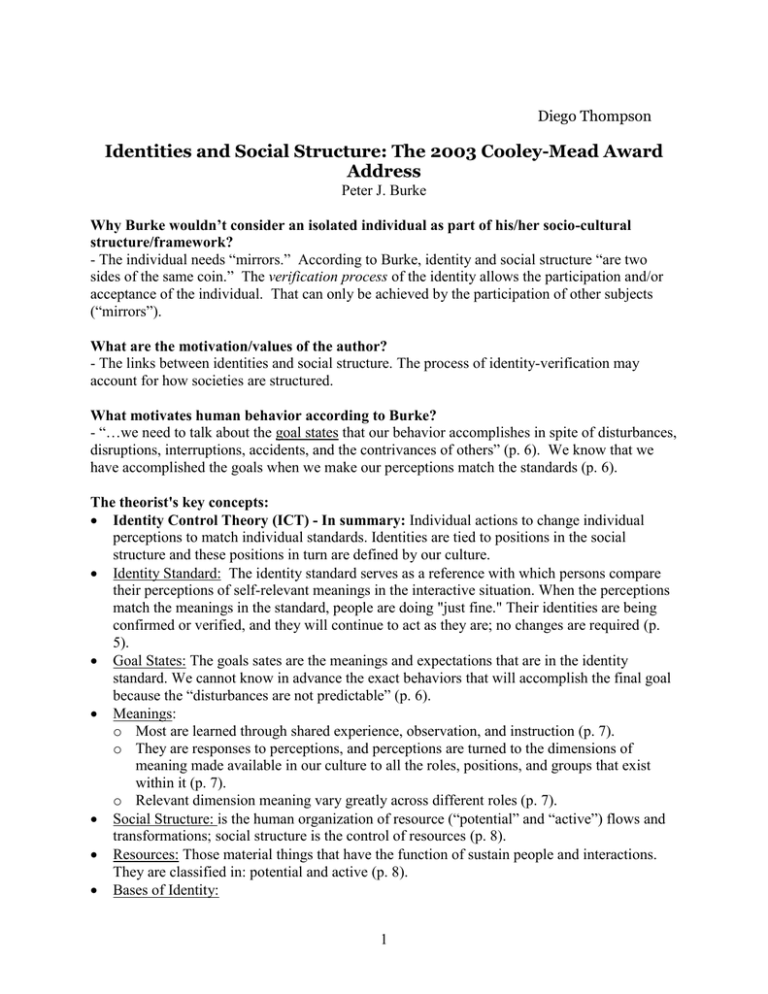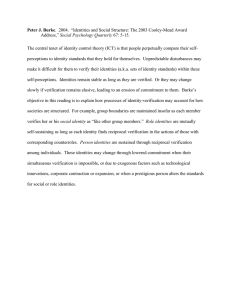Identities and Social Structure: The 2003 Cooley-Mead Award Address
advertisement

Diego Thompson Identities and Social Structure: The 2003 Cooley-Mead Award Address Peter J. Burke Why Burke wouldn’t consider an isolated individual as part of his/her socio-cultural structure/framework? - The individual needs “mirrors.” According to Burke, identity and social structure “are two sides of the same coin.” The verification process of the identity allows the participation and/or acceptance of the individual. That can only be achieved by the participation of other subjects (“mirrors”). What are the motivation/values of the author? - The links between identities and social structure. The process of identity-verification may account for how societies are structured. What motivates human behavior according to Burke? - “…we need to talk about the goal states that our behavior accomplishes in spite of disturbances, disruptions, interruptions, accidents, and the contrivances of others” (p. 6). We know that we have accomplished the goals when we make our perceptions match the standards (p. 6). The theorist's key concepts: Identity Control Theory (ICT) - In summary: Individual actions to change individual perceptions to match individual standards. Identities are tied to positions in the social structure and these positions in turn are defined by our culture. Identity Standard: The identity standard serves as a reference with which persons compare their perceptions of self-relevant meanings in the interactive situation. When the perceptions match the meanings in the standard, people are doing "just fine." Their identities are being confirmed or verified, and they will continue to act as they are; no changes are required (p. 5). Goal States: The goals sates are the meanings and expectations that are in the identity standard. We cannot know in advance the exact behaviors that will accomplish the final goal because the “disturbances are not predictable” (p. 6). Meanings: o Most are learned through shared experience, observation, and instruction (p. 7). o They are responses to perceptions, and perceptions are turned to the dimensions of meaning made available in our culture to all the roles, positions, and groups that exist within it (p. 7). o Relevant dimension meaning vary greatly across different roles (p. 7). Social Structure: is the human organization of resource (“potential” and “active”) flows and transformations; social structure is the control of resources (p. 8). Resources: Those material things that have the function of sustain people and interactions. They are classified in: potential and active (p. 8). Bases of Identity: 1 o Social Identity: is based on membership in a group or category that gives one selfmeanings that are shared with others in a group. One is tied to many similar others; in verifying the self as a group member, one receives recognition, approval, and acceptance from these others (p. 10). o Role Identity: is tied to other members of the role set; verification comes by what one does (performing), not one is. The output of each role is the input to its counterrole (p. 10). o Personal Identity: “what one is”. Personal identity is composed by the salient personal characteristics (p. 10). Identity changes: 1- Identity meanings may change, even when commitment is high, occurs when someone has the power to define or redefine the meanings and expectations associated with particular role or group (p. 12). 2- With innovation (p. 12). 3- Change in the context in which the role relationships exist (ex: changes in resources) (p. 12). 4- Changes in relationships (ex: relationships are gained or lost groups grow or shrink) (p. 12). Stability and change: are often a consequence of the connectedness of identities within the social structure and the distribution of resources (power) across the structure (p. 13). Bases for Identity verification and social structure Role identity Performance Subject Perception Personal Identity Expectations Goals Personal Charac. 2 R R R Social Identity Shared meanings
![Word Study [1 class hour]](http://s3.studylib.net/store/data/007905774_2-53b71d303720cf6608aea934a43e9f05-300x300.png)






